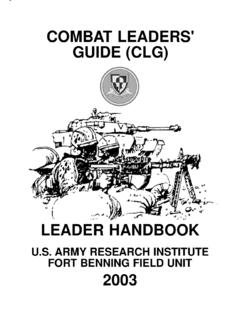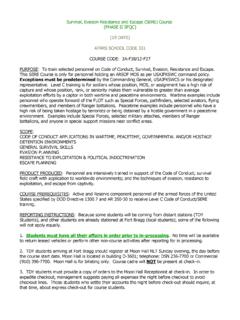Transcription of Report Documentation Page - Defense Technical …
1 Report Documentation PageForm ApprovedOMB No. 0704-0188 Public reporting burden for the collection of information is estimated to average 1 hour per response, including the time for reviewing instructions, searching existing data sources, gathering andmaintaining the data needed, and completing and reviewing the collection of information. Send comments regarding this burden estimate or any other aspect of this collection of information,including suggestions for reducing this burden, to Washington Headquarters Services, Directorate for Information Operations and Reports, 1215 Jefferson Davis Highway, Suite 1204, ArlingtonVA 22202-4302. Respondents should be aware that notwithstanding any other provision of law, no person shall be subject to a penalty for failing to comply with a collection of information if itdoes not display a currently valid OMB control number.
2 1. Report DATE JAN 2010 2. Report TYPE 3. DATES COVERED 00-00-2010 to 00-00-2010 4. TITLE AND SUBTITLE Small Unit Leader s Guide to: The Comand Supply Discipline Program 5a. CONTRACT NUMBER 5b. GRANT NUMBER 5c. PROGRAM ELEMENT NUMBER 6. AUTHOR(S) 5d. PROJECT NUMBER 5e. TASK NUMBER 5f. WORK UNIT NUMBER 7. PERFORMING ORGANIZATION NAME(S) AND ADDRESS(ES) Center for Army Lessons Learned,10 Meade Avenue, Building 50,Fort Leavenworth,KS,66027-1350 8. PERFORMING ORGANIZATIONREPORT NUMBER 9. SPONSORING/MONITORING AGENCY NAME(S) AND ADDRESS(ES) 10. SPONSOR/MONITOR S ACRONYM(S) 11. SPONSOR/MONITOR S Report NUMBER(S) 12. DISTRIBUTION/AVAILABILITY STATEMENT Approved for public release; distribution unlimited 13. SUPPLEMENTARY NOTES 14. ABSTRACT 15. SUBJECT TERMS 16. SECURITY CLASSIFICATION OF: 17. LIMITATION OF ABSTRACT Same asReport (SAR) 18.
3 NUMBEROF pages 48 19a. NAME OFRESPONSIBLE PERSON a. Report unclassified b. ABSTRACT unclassified c. THIS PAGE unclassified Standard Form 298 (Rev. 8-98) Prescribed by ANSI Std Z39-18 COMMAND SUPPLY DISCIPLINE PROGRAM Foreword The Command Supply Discipline Program (CSDP) is a commander s program. This handbook addresses the CSDP every unit must establish and enforce. Leaders must enforce and implement effective programs to ensure resources are being used without fraud, waste, and abuse. This handbook is designed to provide the necessary tools for commanders to successfully address the relationship of good logistical processes and operations achievements which are reached by stressing good supply discipline. Key Lessons: Understanding why CSDP is important. Implementing CSDP in the unit step-by-step. Understanding the types of property and establishing accountability for all property.
4 Documenting the circumstances concerning the loss, damage, or destruction of government property through the financial liability investigations of property loss. Understanding maintenance and supply readiness and how it determines the unit s ability to perform the assigned mission. The Army has been conducting wartime operations for the last eight years. All resources, whether property, people, or time have become increasingly limited. It is imperative that commanders establish and maintain a CSDP requiring units to be good stewards of the resources provided to them. Executing an effective CSDP will help commanders comply with the Department of the Army s goal to keep safe and preserve Army equipment and resources. i COMMAND SUPPLY DISCIPLINE PROGRAM Small Unit Leader's Guide to: The Command Supply Discipline Program Handbook Table of Contents Chapter 1.
5 Introduction 1 Chapter 2. Property Accountability 7 Chapter 3. Maintenance and Supply Readiness 13 Appendix A. Pocket Guide 21 Appendix B. Financial Liability Investigation of Property Loss Procedures 23 Appendix C. Change of Command Helpful Hints 31 Appendix D. Type Authorization Codes 35 Appendix E. References 37 iii CENTER FOR ARMY LESSONS LEARNED Center for Army Lessons Learned Director Colonel Robert W. Forrester Division Chief Dave Bialas CALL Analyst Jack Crafton Production Coordinator Kristine Bell Editor Michael Brooks Graphic Artist Dan Neal Distribution Manager Candice Miller The Secretary of the Army has determined that the publication of this periodical is necessary in the transaction of the public business as required by law of the Department. Unless otherwise stated, whenever the masculine or feminine gender is used, both are intended.
6 Note: Any publications (other than CALL publications) referenced in this product, such as ARs, FMs, and TMs, must be obtained through your pinpoint distribution system. The content of this handbook has been written and prepared by the professional quartermasters of the Logistics Training Department and the Property Book Technicians (warrant officers) attending the Basic and Advanced Warrant Officer Courses at the Army Quartermaster School, Fort Lee, VA. Any questions should be directed to the Logistics Training Department via the Army Quartermaster School Web site. iv COMMAND SUPPLY DISCIPLINE PROGRAM Chapter 1 Introduction Commander s Quick Reference Guide to the Command Supply Discipline Program 1. Purpose. Identify key aspects of the Command Supply Discipline Program (CSDP). Commanders must become actively involved in their units to ensure successful development, implementation, and maintenance of the CSDP.
7 2. Facts. Commanders time is valuable and finite. Knowing unit logistical aspects allows preservation of their time and increases unit efficiency and cohesion. a. Hand receipts. Before signing the primary hand receipt, ensure all property has been accounted and signed for. This includes shortage annexes, maintenance, requisition documents, and sub-hand receipts. The incoming commander will conduct an inventory of property listed on the primary hand receipt within 30 days before assuming command. The inventory will be completed before the new primary hand receipt holder (PHRH) assumes duties or outgoing PHRH departs (whichever is first). When inventory cannot be completed, a written request for an extension will be requested from the next higher command. A maximum of 2 extensions (15 days each) may be granted by the next higher commander, major United States Army reserve command, or State Adjutant General.
8 B. Delegations of authority (Department of the Army [DA] Form 1687). Delegation of authority is a method used to multiply a commander s ability to accomplish specific tasks by authorizing designated Soldiers to perform actions delegated by the commander. c. Food records and signature cards (DA Form 577). Commanders need to verify that unit food records are accurate and update unit signature cards. Food records give a snapshot of the subsistence program and the quantities of food. Updated signature cards, with a copy of the assumption of command, authorize key personnel to act for the commander to support the unit and Soldiers. d. Review of the unit s CSDP records. Commanders need to review CSDP records for accuracy, timeliness, and correction of deficiencies. Commanders should also keep on file all inventories to include monthly, quarterly, cyclic, prescribed load list, sensitive item, physical, serial number, key register, hazardous material, and previous unit logistic inspection results.
9 These reports and findings can be used to identify logistical strengths and weaknesses within the unit. e. Unit funds and purchase accounts. Review each account and ensure the funds allocation is correct. Review past purchases, requests, and allotments for the unit and make necessary adjustments. Knowing what a unit spends The CSDP is a compilation of existing regulatory requirements brought together for visibility purposes. It is directed at standardizing supply discipline throughout the Army. Also, the CSDP is meant to simplify command, supervisory, and managerial 1 CENTER FOR ARMY LESSONS LEARNED responsibilities. Simplification is accomplished by outlining the various requirements for responsible personnel, by streamlining requirements, and formalizing follow-up procedures. Command emphasis is vital to the success of any CSDP.
10 This handbook discusses the importance of CSDP to commanders and gives commanders the necessary tools to implement a CSDP. Further, it addresses the relationship between good logistical processes and operational achievements which are reached by stressing good supply discipline. Commanders must implement and enforce effective programs to ensure resources are being used without fraud, waste, or abuse. It outlines routine and scheduled tasks commanders must adhere to in order to develop, implement, and maintain an effective program. Command Emphasis on the Command Supply Discipline Program: Why Is a Command Supply Discipline Program Important to a Commander? The input of the company s senior leader, within a battalion or higher echelon, dictates how leaders and subordinates respond to requirements. In the absence of leadership, or CSDP emphasis, important requirements are left undone and result in wasted time and the depletion of dollars and resources.













